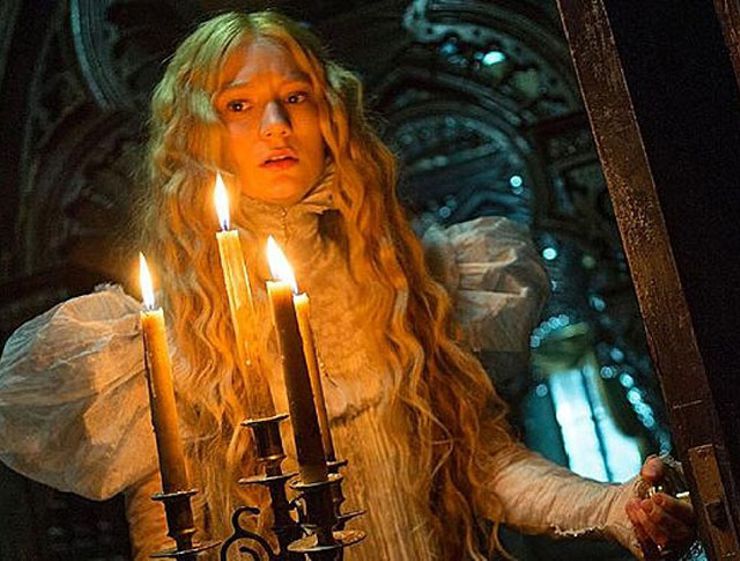Horror director Guillermo del Toro (Pan's Labyrinth) wants everyone to know that his latest film, Crimson Peak, is not a horror film.
“I read E.T.A. Hoffman, Henry James, Edgar Allan Poe, Wuthering Heights, and Great Expectations—everything that’s been affected by the gothic spirit,” del Toro told Film School Rejects. “When I was a kid, one of my favorite writers was Edgar Allan Poe. He has that beautiful tale, ‘The Full of the House of Usher.’ Essentially, Crimson Peak is a cross between a classic gothic romance, like Jane Eyre or something like that, and The House of Usher. I tried to capture the dark spirit that gothic romance has. Marketing may contradict me, but Crimson Peak is not a horror film; it’s a mixture of darkness and beauty, melodrama and eerie atmosphere.”
Though the film’s gothic themes would be obvious to any viewer, here’s a closer look at the complex web of literary inspiration in Crimson Peak.

Mary Shelley’s Monster
When we first meet our heroine Edith Cushing (Mia Wasikowska), a young woman living in turn of the century New York, she’s defending her literary aspirations. As a stuffy society woman reminds her that Jane Austen “died a spinster,” Edith replies, “Actually, I’d prefer to be Mary Shelley. She died a widow.” It’s a telling reference—Shelley, after all, is the author of Frankenstein, a grisly tale of parental responsibility and ultimately, the search for love and acceptance.

The Madwoman in the Attic
The film gets off to a Jane Eyre / Rebecca inspired start. Edith finds herself intrigued by a mysterious English baronet, Sir Thomas Sharpe (Tom Hiddleston). They marry, then return to his family seat Allerdale Hall. The house is horrifyingly decrepit, and Edith finds herself surrounded by shadows and ominous moaning. Like Jane and the narrator of Rebecca, she’s assured that it’s just the wind, an old house settling. (It is, perhaps, not a coincidence that Wasikowska played Charlotte Brontë’s heroine in the most recent film adaptation of Jane Eyre, back in 2011.) Even worse is the fact that Edith and her new husband are not alone—Thomas lives with his sister Lucille (Jessica Chastain), a dark and serious beauty whose lurking evokes a sexier version of Mrs. Danvers, the chilly housekeeper from Rebecca.

Brother and Sisterly Love
It’s obvious that the Sharpe siblings are in on something. But what? Here is where the film shifts from “the madwoman in the attic” trope of Jane Eyre and Rebecca, and goes full-on Poe, taking much of its inspiration from his story “The Fall of the House of Usher.” In Poe’s story, unnamed narrator (like the narrator in Rebecca) finds himself called to his friend Roderick’s decrepit family estate, where he lives with his sister Madeline. Edith, in Crimson Peak, is similarly third-wheeling it. Though Poe never truly comes out and writes it directly, Roderick and Madeline also share a dark secret. One can even see the similarities between Chastain, in style and appearance, and Myrna Fahey, who played Madeline in the Vincent Price 1960 film version of House of Usher.

Monstrous Love
But horror fans shouldn’t be too disappointed. There are still plenty of thrills throughout Crimson Peak to satisfy those out for blood. The house, for one, is built on a mine of red clay, so everything everywhere seeps thick red goop. And del Toro’s penchant for ghoulish monsters like those that you may remember—or not be able to forget—from Pan’s Labyrinth are still there.
Del Toro claims that in making Crimson Peak he had hoped to play with gender roles and present a narrative driven by strong female characters. “Normally, in gothic romance, females end up being damsels in danger,” del Toro explained to Film School Rejects. “They end up being rescued by Fabio without a shirt. I wanted this movie to be very centric to the female figures.”
Readers of Rebecca, Jane Eyre, and even Poe’s tales know that women are often victims. But the question that both “Usher” and Crimson Peak ask is: Can women also be monsters?
